

First Circumnavigation of the world - Earliest long distance voyagers - African coast voyages - Indian Ocean crossings - Voyages to the Americas
Sailing across oceans, especially in search of unknown places, has fascinated adventurous men since ancient times.
American and European histories dwell on the adventurous voyages of discovery of Cabot, Columbus, Cook, Drake, Magellan and Vasco de Gama. We consider them to be the first to discover America, the Indian and Pacific Oceans.
The Portuguese sailor Ferdinand Magellan is credited as being the first man to sail around the world. He was appointed commander of a fleet of five ships by king Carlos V of Spain at the beginning of the 16th. century. The aim was to find a way round the south tip of America to establish a new route to the Spice Islands. They departed from Sanlucar on 20th of September, 1519. He discovered the strait which has been given his name, and reached the Pacific Ocean on 28th of November, 1520. With the remaining three vessels of his fleet, he reached Cebu,in the heart of the Philippines the 7th of April, 1521. Magellan, the first European to reach these islands, was killed in a clash with natives on the neighboring island of Mactan, April 27, 1521. Even though he did not complete the voyage, it was Magellan's perseverance and leadership that made the first circumnavigation possible.
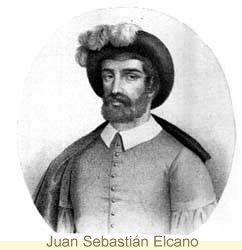 The actual title of "First to circumnavigate the World" belongs to Juan Sebastian de Elcano, one of Magellan's captains, who succeeded in bringing "Victoria", the only surviving vessel of the original fleet, back to the Spanish port Sanlucar de Barrameda on the 6th of December, 1522.
The actual title of "First to circumnavigate the World" belongs to Juan Sebastian de Elcano, one of Magellan's captains, who succeeded in bringing "Victoria", the only surviving vessel of the original fleet, back to the Spanish port Sanlucar de Barrameda on the 6th of December, 1522.
Of the 239 men that left Seville in five ships only 17 returned. Most had perished from starvation and scurvy. Others died in accidents and clashes with natives. Some died in Portuguese prisons. We know the details of this extraordinary voyage from the complete log that was kept by an Italian crew-member, Antonio Lombardo Pigafetta. Portions of the translations of this log-book, as well as translations of other documents relating to this historic voyage, may be read here. The original manuscript in Italian is in the Ambrosian Library in Milan.
In the service of king Manuel of Portugal, Fernando Magellan (Fernão de Magalhães in Portuguese) had previously sailed round the Cape of Good Hope (the southern tip of Africa) as far east as Ambon and Banda in the Mollucan Islands, then called the Spice Islands, the rich source of nutmeg and cloves. These islands are further east than the Philippines, consequently it is correct to state that Magellan had sailed all around the world, because he had crossed all the meridians in two separate voyages . He returned to Portugal in 1512 and fell out of favor with the Portuguese court. He then went to the Spanish court to obtain support to search for a westbound passage to the Spice Islands.
 The first Pacific Ocean crossings were undoubtedly accomplished by Austronesian peoples, who, over a period of at least 5000 years, have spread out from Taiwan or the Malaysian area throughout the islands of the Pacific Ocean and even westward toward Madagascar. There is no written history of these voyages, but linguistics and genetic studies of the last 50 years have clearly established the pattern of migrations.
The first Pacific Ocean crossings were undoubtedly accomplished by Austronesian peoples, who, over a period of at least 5000 years, have spread out from Taiwan or the Malaysian area throughout the islands of the Pacific Ocean and even westward toward Madagascar. There is no written history of these voyages, but linguistics and genetic studies of the last 50 years have clearly established the pattern of migrations.
It has become clear that by 2500 years ago the peoples of Oceania had acquired the ability to build seaworthy outrigger canoes and to navigate thousands of miles using the stars, ocean currents and swells. Certainly some individuals who served as navigators had inborn capabilities similar to those possessed by migrating birds. Unfortunately modern civilization has destroyed these capabilities.
However there still exist a few practitioners of this art. One of them is
Mau Piailug, who was taught the ancient art by his grandfather. In 1976 he successfully navigated a Polynesian double-hulled canoe Hokule'a from Hawaii to Tahiti, without charts or any navigational instruments. Today, in his seventies, he is teaching young Polynesians the navigational arts at a school on the island Satawal in the Carolines.
Hieroglyphics in Egyptian tombs tell of voyages as early as 3000 B.C. down the Red Sea to the legendary land of Punt (probably modern Somalia), to bring back cargoes of myrrh, gold and valuable wood. But Egyptian ships were built for travel on the Nile and were not suitable for long sea-going voyages.
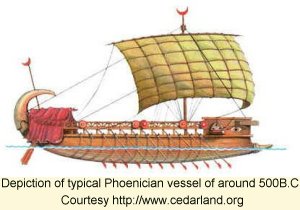 From 1200 B.C. the Phoenicians developed a sea-going vessel with a keel, built of local cedar. They were a sea-faring and trading people inhabiting a group of city-states (Tyre, Byblios, Sidon and others) along the eastern shore of the Mediterranean which is present day Lebanon. Although they developed a 22 letter alphabet, upon which our modern alphabet is based, all their writings were on papyrus which disintegrated or were destroyed during later invasions of Assyrians, Babylonians and Persians. Most of what we know of their history is from others.
From 1200 B.C. the Phoenicians developed a sea-going vessel with a keel, built of local cedar. They were a sea-faring and trading people inhabiting a group of city-states (Tyre, Byblios, Sidon and others) along the eastern shore of the Mediterranean which is present day Lebanon. Although they developed a 22 letter alphabet, upon which our modern alphabet is based, all their writings were on papyrus which disintegrated or were destroyed during later invasions of Assyrians, Babylonians and Persians. Most of what we know of their history is from others.
945 B.C. the Jewish king Solomon learned the location of the Egyptian gold from his wife, the daughter of a pharaoh. He contracted with King Hiram of Tyre to send a fleet down the coast of Africa to bring back gold and other treasure. This voyage took three years, described in I Kings 9 of the Hebrew Bible. The location of the mines is unknown, but some historians have concluded that they were located in present day Zimbabwe. The river Sofala in modern Mozambique provides access, and was used by Arab traders as early as 915 A.D. for access to the gold mines. The Phoenicians continued these voyages for many years bringing back treasures for their own trade, and possibly they built at least some of the fortifications, which can still be seen today.
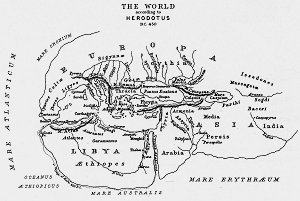 In 600 B.C. the Egyptian pharaoh Necho II contracted with the Phoenicians for a voyage of discovery, which sailed down the east coast of Africa, around the Cape and back to Alexandria, three years later, through the Strait of Gibraltar. This voyage is recorded by the Greek historian Herodotus in book 4: " ...The Phoenicians set out from the Arabian sea and sailed the southern sea. Whenever autumn came they landed and planted grain in the part of Libya they had reached, and there they waited for harvest time. Then, after gathering the crop, they continued their voyage, so that two years had passed. It was in the third year that they rounded the Pillars of Heracles and returned to Egypt. There they claimed and some may believe it, though I do not, that when sailing around Libya they had the sun on their right hand. The Greeks at that time were unaware that south of the equator the sun would be north of a sailor. About this time, the Egyptians dug a canal connecting the Nile delta with the Red Sea, Phoenician sailors used this canal in voyages to Yemen and eastern Africa, possibly even India.
In 600 B.C. the Egyptian pharaoh Necho II contracted with the Phoenicians for a voyage of discovery, which sailed down the east coast of Africa, around the Cape and back to Alexandria, three years later, through the Strait of Gibraltar. This voyage is recorded by the Greek historian Herodotus in book 4: " ...The Phoenicians set out from the Arabian sea and sailed the southern sea. Whenever autumn came they landed and planted grain in the part of Libya they had reached, and there they waited for harvest time. Then, after gathering the crop, they continued their voyage, so that two years had passed. It was in the third year that they rounded the Pillars of Heracles and returned to Egypt. There they claimed and some may believe it, though I do not, that when sailing around Libya they had the sun on their right hand. The Greeks at that time were unaware that south of the equator the sun would be north of a sailor. About this time, the Egyptians dug a canal connecting the Nile delta with the Red Sea, Phoenician sailors used this canal in voyages to Yemen and eastern Africa, possibly even India.
The Phoenicians established many colonies in Sicily, in Spain, and North Africa. The most important was Carthage, which became a powerful state controlling all Mediterranean trade. It was founded in 814 B.C. After the original Phoenician city-states became a province of Persia in 536 B.C., Carthage controlled the Phoenician colonies in the western Mediterranean.
Voyagers from Carthage used a version of the cross-staff to enable them to estimate their latitude. They traveled out into the Atlantic ocean as far north as the British isles from where they brought tin, the essential ingredient in making the alloy bronze. They also established colonies along the west coast of Africa (now Morocco) and in the Madeira and Canary islands.
About 450 B.C., Hanno the Navigator lead an expedition of about 60 vessels down the coast of west Africa. Hanno and part of the expedition got as far as Cameroon, the sighting of the volcano was quoted. They returned to Carthage with the skins of three gorillas and a number of black slaves.
Carthaginian sailors also reached the Azores, although there is no written record. However a number of Cartaginian artifacts, including coins from about 300 B.C. have been found on the islands.
The Carthaginians were excellent sailors but not so good fighting on land and were the losers in all three Punic wars against Rome. A notable exception is the renowned general Hannibal who crossed the Alps with elephants and won several battles against Rome in 218 B.C.. After the third Punic war, the Romans totally destroyed the city of Carthage and killed most of the inhabitants in 146 BC.
Nearly 1550 years passed before Europeans again visited the islands and coast of west Africa. By then they had acquired the magnetic compass from the Arabs, the astrolabe had improved the calculation of latitude.
In 1393 a Spanish navigator Alomanaster visited Lancerote in the Canary Islands, but the Spanish court did not follow up. Prince Henry of Portugal was determined to expand knowledge of the dark continent, having learned from captured Arabs that south of the Sahara desert many riches were to be found, including gold. In 1415 the Portuguese captured Ceuta, in Morocco, from the Arabs and in 1418 re-discovered the Madeira and Azore islands. Further expeditions gradually pushed further south, finally reaching Sierra Leone in 1462. Prince Henry died in 1463 and further voyages were undertaken by Lisbon trading companies.
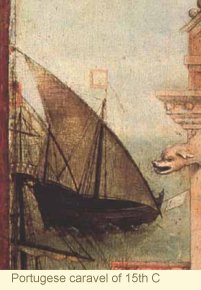 Finally in January, 1488 Bartholomeu Dias unknowingly rounded the southern tip of Africa in a great storm. He and his fleet of three ships finally anchored in what is now known as Mossel Bay. He followed the coast northward to just east of present day Port Elizabeth. Then his rebellious crew forced him to turn back.
Finally in January, 1488 Bartholomeu Dias unknowingly rounded the southern tip of Africa in a great storm. He and his fleet of three ships finally anchored in what is now known as Mossel Bay. He followed the coast northward to just east of present day Port Elizabeth. Then his rebellious crew forced him to turn back.
Using the charts and information obtained by Dias,
Vasco da Gama left Lisbon with a fleet of four ships on 8 July 1497. They passed the easternmost point reached by Dias 16 December and continued northward, looting Arab ships in Mombasa, half way up the African east coast. There they took on an Arab pilot and reached Calicut, on the west coast of India, 20 May 1498. Successive voyages strengthened the Portuguese control of the prosperous trade in eastern riches and spices with Europe, that had previously been the monopoly of the Arabs.
Sailing across the northern Indian Ocean is controlled by the
Monsoon winds. In summer they blow from the south-west towards India and Malaysia, in winter they blow from the north-east towards Africa. The north equatorial sea current also reverses direction, although its easterly flow in summer is much stronger.
South of the equator, at the latitude of Madagascar the south-easterly trade wind blows throughout the year and together with the west going south equatorial current made it easy for the Austronesian people to migrate to Madagascar sometime around 1000 B.C.
Arab traders were well aware of these winds and currents and by 600 A.D. had dominated the rich trade in precious stones, silks and spices from east Africa, India, China and Indonesia to Europe. Later Arab sailors also used compasses obtained from the Chinese who had discovered the properties of magnetized iron in the 1st century B.C.. Arab dhows used lateen sails which allowed sailing closer to the wind than the square sails used by others.
The hegemony of the Arab trading fleets was shattered by the successful ventures of the Portuguese fleets to India and beyond in the 15th. century. The Portuguese had also learned the advantage of lateen sails which allowed sailing much closer to the wind, greatly increasing the speed of voyages
Chinese junks, some as large as 500 feet long, were used to sail throughout the Far East and crossing the Indian Ocean to Africa, from at least the 9th century A.D. until the Ming dynasty. The famous Venetian traveler Marco Polo returned to Europe on a Chinese fleet which reached the Persian Gulf in 1275 A.D. Under emperor Zhu Di in 1421, admiral Zheng He lead a fleet of over a hundred junks to the Pacific and Indian oceans with instructions to go to the edges of the earth. There have been conjectures that they reached the American continent from both east and west. However the Chinese then turned their interests inward and abandoned any further ocean sailing and destroyed all records of earlier voyages. The last recorded voyage of a Chinese fleet to the western Indian Ocean occurred in 1433. Venetian maps of the world drawn at the end of the 15th century (before the voyage of Magellan) show details of the west coast of south America. Possibly they were based on information brought from China by traders?
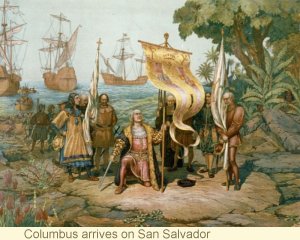 We have all been taught that the Genoan sailor in the service of Queen Isabella of Spain, Christopher Columbus discovered America on 12 October 1492, believing that he had reached the Indies. In fact he had landed on an island which he called San Salvador in what we now know as the Bahamas. Then he discovered the islands Hispaniola and Cuba and established settlements. However in later voyages he did land on the mainland. The first permanent Spanish settlement on the American mainland was Darien in Panama, settled by Vasco Nuñez de Balboa in 1512. Balboa saw the Pacific Ocean for the first time the following year.
We have all been taught that the Genoan sailor in the service of Queen Isabella of Spain, Christopher Columbus discovered America on 12 October 1492, believing that he had reached the Indies. In fact he had landed on an island which he called San Salvador in what we now know as the Bahamas. Then he discovered the islands Hispaniola and Cuba and established settlements. However in later voyages he did land on the mainland. The first permanent Spanish settlement on the American mainland was Darien in Panama, settled by Vasco Nuñez de Balboa in 1512. Balboa saw the Pacific Ocean for the first time the following year.
Columbus's discovery started a rush of voyages by other nations. In June 1497, the Venetian sailor Giovani Caboto
( John Cabot), who had been hired by King Henry VII of England to find a northern passage to the Indies, saw land and disembarked briefly. He returned full of enthusiasm, believing that he had discovered Asia. However his log has been lost, but based on contemporary accounts it appears that the land was the east coast of Newfoundland. On his next voyage the following year he was lost, only one of his five ships returned badly damaged.
In 1500 the Portuguese sailor, Gaspar Corte Real, son of the governor of the Azores islands, reached a cold, snow-covered land in the northwestern Atlantic, most likely Newfoundland. He reported great schools of cod in the waters off that coast. The following year he was lost on the return from his second voyage to this land, but one of the ships of his fleet brought captured natives back to Lisbon.
By contrast Brazil was discovered in 1500 by accident. King Manuel I of Portugal appointed Pedro Alvares Cabral to command a fleet of 13 ships on a voyage to India, using charts and directions supplied by Dias and Vasco de Gama. Probably because of adverse winds, they took a more westerly course and on 22 April they sighted a mountain. On the 25th the entire fleet sailed into the bay called Porto Seguro. May 3rd the fleet continued on its voyage to India, but Cabral sent one ship back to Lisbon with the news of the discovery of what he thought was an island, to which he gave the name Vera Cruz. Permanent settlements were not established in Brazil until 1532, when Martim Alfonso de Sousa established Sao Vicente near present day Santos.
All the later voyages of Spanish explorers and those of other nations establishing colonies in the America are all well known and will not be discussed here.
However, we now know that other Europeans reached the shores of North America before Columbus. Those that have been well documented are the Viking colony established in Greenland by Erik the Red in 982.
Subsequently other Vikings reported landings on islands west of Greenland. About 1000 A.D., Erik's son Leif Eriksson established a colony on what he called
Vinland. . Several years later the colony was abandoned. As climatic conditions became increasingly harsh the Greenland colonies were also abandoned in the late 15th century. Between 1960 and 1966 the site of a Viking settlement was uncovered and explored at L'Anse aux Meadows on the northern tip of Newfoundland. This is believed to be the Vinland colony of Leif Eriksson.
It seems likely that even earlier people had reached America from Europe, particularly following the route of the Trade Winds from the Canary Islands to the Gulf of Mexico. It is well known that the Aztecs and the Incas welcomed the Spaniards because of an ancient legend that light-haired blue-eyed men had previously arrived in Yucatan. Hernan Cortes had a consort Doña Marina, an Aztec princess reputed to be with lighter complexion. Some have theorized that these light skinned invaders could have been Vikings who had sailed down the coast of America, or had crossed the Atlantic from Normandy by following the currents south to the Azores than crossed the Atlantic with the Trade Wind. It would also have been possible for Phoenicians , who had already visited the Azores, to have continued westward, perhaps after the defeat of Carthage in 146 B.C.
When Pizarro arrived in Peru he found that the Incas had similar legends. Historians of the time also noted light-skinned people among the royal families.
In North America one Indian tribe, the
Mandan aroused much interest because of the large number with light skin and blue eyes. The historian and artist George Catlin lived among them for several months in 1832. He noted that the legendary Welsh chieftain Madoc sailed westward in 1170 with a fleet of 10 ships and disappeared. Catlin also noted some similarities of Mandan and Welsh words. Therefore he wondered if Madoc had reached America and settled among this tribe which at that time lived on the east coast.
Another theory has been proposed that settlers from the Viking colony on Greenland, who had mysteriously vanished in the 14th century might have reached the east coast of North America and mingled with native tribe.
Modern DNA comparison techniques might have been able to resolve these theories. Unfortunately the Mandan tribe was entirely wiped out by a smallpox epidemic 150 years ago. The light-skinned people in South America have also disappeared, victims of the brutal Spanish rule in the 16th and 17th centuries.
Return to top of page.
Go to Index to History articles
Oceania Homepage
history of Oceania's peoples
Many links
The Age of Exploration
many biographies, links
